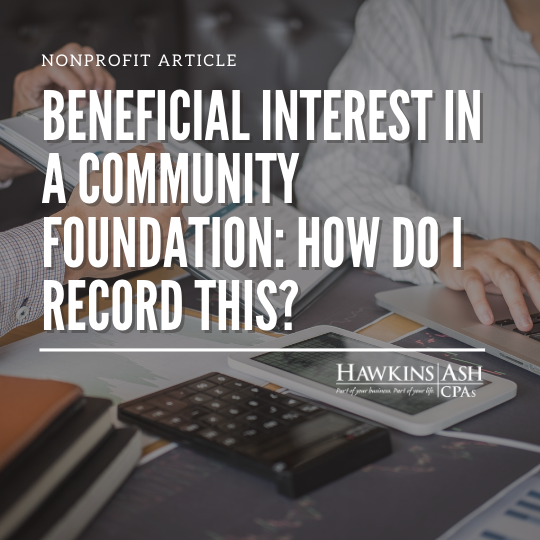A community foundation (“Foundation”) is a tax-exempt charitable organization that focuses primarily on addressing community needs and supporting local non-profit organizations in a specific geographical area through funds it maintains and administers on behalf of multiple donors.
Over the years, there has been significant growth in the number of non-profit organizations (“Organization”) moving cash and other financial assets to these Foundations to establish endowment funds or other designated accounts. Benefits to the Organization would include:
- professional investment management
- basic administrative services and technical assistance provided by the Foundation
- increased community awareness and potential giving opportunities with donors that give to the Foundation, and
- increased donor confidence of the Organization through their affiliation with the Foundation which is a “strong stewardship of Organization assets.”
Although the record-keeping for this transaction from the Organization’s standpoint may appear simplistic (similar to any other investment transaction with a third-party investment manager), there are multiple things to consider in the asset transfer to the Foundation:
- Does the Organization retain the right to redirect the assets to another beneficiary?
- Is the transfer revocable or repayable?
- Has the Organization specified itself or its affiliate as the beneficiary?
- Did the Organization, or donor, grant variance power to the Foundation?
- Are the Organization and the Foundation financially interrelated?
The two illustrations below – taken directly from the FASB Accounting Standards Codification (the source of authoritative generally accepted accounting principles [GAAP]), provide two very common situations in a transaction between an Organization and Foundation:
Recipient Entity is Granted Variance Power
The governing board of City Botanical Society E decides to raise funds to build an endowment. The governing board signs an agreement to establish a fund at Community Foundation F. Community Foundation F and City Botanical Society E are not financially interrelated entities. City Botanical Society E solicits gifts to the fund. The campaign materials inform donors that the endowment will be owned and held by Community Foundation F. The materials explain that the gifts will be invested and that the return from their investment will be distributed to City Botanical Society E, subject to Community Foundation F’s spending policy and to Community Foundation F’s right to redirect the return to another beneficiary without the approval of the donor, City Botanical Society E, or any other party if distributions to City Botanical Society E become unnecessary, impossible, or inconsistent with the needs of the community. The donor-response card also clearly describes the Community Foundation F’s right to redirect the return of the fund. The campaign materials indicate that donors should send their contributions to Community Foundation F using a pre-addressed envelope included for that purpose.
Community Foundation F would recognize the fair value of gifts received as an asset and as contribution revenue. The donors explicitly granted variance power by using a donor-response card that clearly states that gifts are subject to Community Foundation F’s unilateral power to redirect the return to another beneficiary.
City Botanical Society E is precluded from recognizing its potential rights to the assets held by Community Foundation F because the donors explicitly granted variance power. City Botanical Society E would recognize only its annual grants from Community Foundation F as contributions.
Whether a donor intended to make a contribution to Community Foundation F may not be clear if the donor responds to the campaign materials by sending a contribution and the donor-response card directly to City Botanical Society E. City Botanical Society E could resolve the ambiguity by a review of the facts and circumstances surrounding the gift, communications with the donor, or both. If it is ultimately determined that the donor intended to make a gift to the fund owned and held by Community Foundation F and to explicitly grant variance power, City Botanical Society E would be an agent responsible for transferring that gift to Community Foundation F.
Resource Provider Names Itself as the Specified Beneficiary
Symphony Orchestra M receives a large gift of securities without donor restrictions from an individual. Because it has no investment expertise, Symphony Orchestra M transfers the securities to Community Foundation N to establish an endowment fund. The agreement between Symphony Orchestra M and Community Foundation N states that the transfer is irrevocable and the transferred assets will not be returned to Symphony Orchestra M. However, Community Foundation N will make annual distributions of the income earned on the endowment fund, subject to Community Foundation N’s spending policy. The agreement also permits Community Foundation N to substitute another beneficiary in the place of Symphony Orchestra M if Symphony Orchestra M ceases to exist or if the governing board of Community Foundation N votes that support of Symphony Orchestra M is no longer necessary or is inconsistent with the needs of the community (that is, Symphony Orchestra M explicitly grants variance power to Community Foundation N). The agreement does not permit either entity to appoint members to the other entity’s governing board or otherwise participate in the policymaking process of the other.
Community Foundation N would recognize the fair value of the transferred securities as an increase in investments and a liability to Symphony Orchestra M because Symphony Orchestra M transferred assets to the Community Foundation N and specified itself as beneficiary. The transfer is not an equity transaction because Community Foundation N and Symphony Orchestra M are not financially interrelated entities. Symphony Orchestra M is unable to influence the operating or financial decisions of Community Foundation N.
Symphony Orchestra M would recognize the fair value of the gift of securities from the individual as contribution revenue. When it transfers the securities to Community Foundation N, it would recognize the transfer as a decrease in investments and an increase in an asset; for example, a beneficial interest in assets held by Community Foundation N. Also, Symphony Orchestra M would disclose in its financial statements the identity of Community Foundation N, the terms under which Community Foundation N will distribute amounts to Symphony Orchestra M, a description of the variance power granted to Community Foundation N, and the aggregate amount reported in the statement of financial position and how that amount is described.
The above illustrations provide two common reporting examples for transactions occurring between an Organization and a Foundation; however, all situations are different. If your non-profit organization decides to pursue a relationship with a community foundation, your first call should be to your Hawkins Ash CPAs representative.





